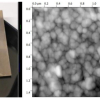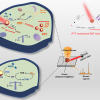![Rapid detection of bacterial infection [Xanthomonas campestris pv. Campestris (Xcc)] in the leafy vegetable choy sum using quantitative Raman spectroscopy-based algorithm. On the right, the Infection Response Index is shown, which can aid farmers to identify infections and take action. Image courtesy of the Singapore-MIT Alliance for Research and Technology](/sites/default/files/styles/product_photo/public/news/Raman_bacteria-w.jpg?itok=nT7hzUUo)
Researchers from the Disruptive and Sustainable Technologies for Agricultural Precision (DiSTAP) Interdisciplinary Research Group (IRG) of Singapore-MIT Alliance for Research and Technology (SMART), MIT’s research enterprise in Singapore, and their local collaborators from Temasek Life Sciences Laboratory (TLL), have developed a rapid Raman spectroscopy-based method for detecting and quantifying early bacterial infection in crops. The Raman spectral biomarkers and diagnostic algorithm enable the non-invasive and early diagnosis of bacterial infections in crop plants, which can be critical for the progress of plant disease management and agricultural productivity.
“The early detection of pathogen-infected crop plants is a significant step to improve plant disease management”, says Chua Nam Hai, DiSTAP co-lead principal investigator. “It will allow the fast and selective removal of pathogen load and curb the further spread of disease to other neighbouring crops.”
Traditionally, plant disease diagnosis involves a simple visual inspection of plants for disease symptoms and severity. “Visual inspection methods are often ineffective, as disease symptoms usually manifest only at relatively later stages of infection, when the pathogen load is already high and reparative measures are limited. Hence, new methods are required for rapid and early detection of bacterial infection. The idea would be akin to having medical tests to identify human diseases at an early stage, instead of waiting for visual symptoms to show, so that early intervention or treatment can be applied”, says MIT Professor Rajeev Ram from DiSTAP.
While existing techniques, such as current molecular detection methods, can detect bacterial infection in plants, they are often limited in their use. Molecular detection methods largely depend on the availability of pathogen-specific gene sequences or antibodies to identify bacterial infection in crops; the implementation is also time-consuming and nonadaptable for on-site field application due to the high cost and bulky equipment required, making it impractical for use in agricultural farms.
“At DiSTAP, we have developed a quantitative Raman spectroscopy-based algorithm that can help farmers to identify bacterial infection rapidly. The developed diagnostic algorithm makes use of Raman spectral biomarkers and can be easily implemented in cloud-based computing and prediction platforms. It is more effective than existing techniques as it enables accurate identification and early detection of bacterial infection, both of which are crucial to saving crop plants that would otherwise be destroyed,” explains Gajendra Pratap Singh of DiSTAP.
A portable Raman system could be used on farms to provide farmers with an accurate and simple yes-or-no response when used to test for the presence of bacterial infections in crops. The development of this rapid and non-invasive method could improve plant disease management and have a transformative impact on agricultural farms by efficiently reducing agricultural yield loss and increasing productivity.
The researchers are currently working on the development of high-throughput, custom-made portable or hand-held Raman spectrometers that will allow Raman spectral analysis to be quickly and easily performed on field-grown crops.














